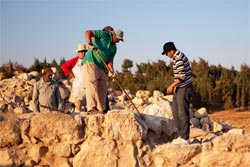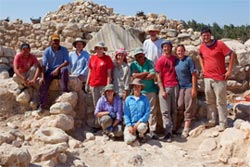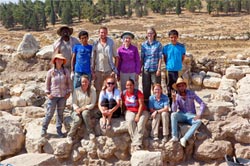Weekly Reports from Jordan
Choose Year: or Choose week
Archaeological Impressions: Week 2
By Kent V. Bramlett, Chief Archaeologist
 The first real week of excavation began with ambitious goal-setting and digging in (literally) to the challenges accepted. We’ve chosen to open three fields, A, H, and L and concentrate our efforts there. This season, each field has a clearly defined goal.
The first real week of excavation began with ambitious goal-setting and digging in (literally) to the challenges accepted. We’ve chosen to open three fields, A, H, and L and concentrate our efforts there. This season, each field has a clearly defined goal.
 Field A, supervised by Stephanie Brown of UC Berkeley, has rallied team members Sashiere Stewart, Vera Kopecky, Cassandra Huson, Audrey Shaffer, Tevin Maker, Murray Brandstater, Craig Tyson, and Britney Szakacs, to complete the excavation of “House D,” the fourth in a neighborhood of early Iron Age houses from about 1200 BC, the time of the biblical Judges. We began uncovering this house during the 2010 season, but walls from a later building obscured much of the floor plan.
Field A, supervised by Stephanie Brown of UC Berkeley, has rallied team members Sashiere Stewart, Vera Kopecky, Cassandra Huson, Audrey Shaffer, Tevin Maker, Murray Brandstater, Craig Tyson, and Britney Szakacs, to complete the excavation of “House D,” the fourth in a neighborhood of early Iron Age houses from about 1200 BC, the time of the biblical Judges. We began uncovering this house during the 2010 season, but walls from a later building obscured much of the floor plan.  Inter-seasonal collapse badly damaged that later building and it was decided to remove more walls to facilitate further exposure of ‘Umayri’s signature period, the early Iron I. Several days of removing rubble and stones transitioned late this week to more typical archaeological activities: balk trimming, careful removal of five cm thick “peels” across string-gridded excavation areas, and cleaning around wall stones to prep for documentation photos.
Inter-seasonal collapse badly damaged that later building and it was decided to remove more walls to facilitate further exposure of ‘Umayri’s signature period, the early Iron I. Several days of removing rubble and stones transitioned late this week to more typical archaeological activities: balk trimming, careful removal of five cm thick “peels” across string-gridded excavation areas, and cleaning around wall stones to prep for documentation photos.
 Over in Field H, supervisor Monique Vincent and assistant supervisor, Nikki Oakden, are determined to finish the excavation of another early Iron I residential building. This house features in Monique’s University of Chicago dissertation research but there are several things we don’t yet understand about the building.
Over in Field H, supervisor Monique Vincent and assistant supervisor, Nikki Oakden, are determined to finish the excavation of another early Iron I residential building. This house features in Monique’s University of Chicago dissertation research but there are several things we don’t yet understand about the building.  The unknowns could be grouped under three categories: date, plan, and original construction. Regarding the building’s date, we know it fits in the 12th century BC, but we think it might be from about a generation later than the village further north in Fields A and B. We hope to recover short-lived samples such as olive pits and seeds for 14C dating to complement the ceramic typological analysis. We also need to establish with certainty the southern limit of the structure. A massive wall from a later period obscures what we think is the south wall of the building, but removal of the later additions will confirm or disconfirm this.
The unknowns could be grouped under three categories: date, plan, and original construction. Regarding the building’s date, we know it fits in the 12th century BC, but we think it might be from about a generation later than the village further north in Fields A and B. We hope to recover short-lived samples such as olive pits and seeds for 14C dating to complement the ceramic typological analysis. We also need to establish with certainty the southern limit of the structure. A massive wall from a later period obscures what we think is the south wall of the building, but removal of the later additions will confirm or disconfirm this.

 Most of the Field H’s hired Jordanian laborers were working this week on the wall removal. This is an exhausting task which involves breaking the large stones with sledge hammers into manageable pieces. The third unknown regards the nature of the original construction. The components of the entire building may be contemporaneous, but we suspect that the basic divisions into rooms was imposed on an older structure represented by the outer walls. Only a probe or two below the 12th century floor will inform us of any previous life of its largest walls.
Most of the Field H’s hired Jordanian laborers were working this week on the wall removal. This is an exhausting task which involves breaking the large stones with sledge hammers into manageable pieces. The third unknown regards the nature of the original construction. The components of the entire building may be contemporaneous, but we suspect that the basic divisions into rooms was imposed on an older structure represented by the outer walls. Only a probe or two below the 12th century floor will inform us of any previous life of its largest walls. 
 Matthew Murdoch and Jillian Logee confirmed the location of the entrance and found the doorway surface. Stephen Lemmer, Carolyn Waldron, Larry Murrin, and Ruth Kent excavated a balk in the western sector of the house and found the continuation of the wall there. Robyn Gray and Nicole Lalonde, under the guidance of Nikki Oakden, are searching for the foundations of the building along the south side and meanwhile found a nice javelin point.
Matthew Murdoch and Jillian Logee confirmed the location of the entrance and found the doorway surface. Stephen Lemmer, Carolyn Waldron, Larry Murrin, and Ruth Kent excavated a balk in the western sector of the house and found the continuation of the wall there. Robyn Gray and Nicole Lalonde, under the guidance of Nikki Oakden, are searching for the foundations of the building along the south side and meanwhile found a nice javelin point.
 Field L, supervised by Carrie Duncan, has undergone recent changes. Last summer a limited expedition saw removal of most Hellenistic walls (second century BC). This exposed and connected the 7th and 6th century Iron Age walls beneath. Most of these have been partially exposed for several years so we are completing our understanding of them.
Field L, supervised by Carrie Duncan, has undergone recent changes. Last summer a limited expedition saw removal of most Hellenistic walls (second century BC). This exposed and connected the 7th and 6th century Iron Age walls beneath. Most of these have been partially exposed for several years so we are completing our understanding of them.
 Mary Boyd, Deirdre Hackleman, and Megan Bereza are removing the last of a balk that is no longer necessary, which removal will help clarify the tangle of wall elements and tumble. Kevin Burrell, Elizabeth Monterrey, and Kailee Laugher have identified a surface associated with a couple of the late Iron Age walls and will explore the founding level of those walls. Erin Matthews and Leon Kent have the exciting challenge of excavating against a mysterious wall composed of some of the largest stones on our site. We don’t know the date of that structure, but the tops of those huge stones have beckoned us and we will learn this season whether they are from the Iron Age or date to the Bronze Age. We will keep you posted!
Mary Boyd, Deirdre Hackleman, and Megan Bereza are removing the last of a balk that is no longer necessary, which removal will help clarify the tangle of wall elements and tumble. Kevin Burrell, Elizabeth Monterrey, and Kailee Laugher have identified a surface associated with a couple of the late Iron Age walls and will explore the founding level of those walls. Erin Matthews and Leon Kent have the exciting challenge of excavating against a mysterious wall composed of some of the largest stones on our site. We don’t know the date of that structure, but the tops of those huge stones have beckoned us and we will learn this season whether they are from the Iron Age or date to the Bronze Age. We will keep you posted!
 Elsewhere on the tell, we are engaged with an ambitious plan to document several of the previously excavated structures with 360-degree 3D photography, LIDAR (a type of laser room-scanning technology), and boom photography. Already, Matt Vincent has begun a series of 360 “panos” or panorama shots taken with an automated 3D camera system. We are truly excited where this season is taking us and we expect the next few weeks will be exciting ones of efforts rewarded.
Elsewhere on the tell, we are engaged with an ambitious plan to document several of the previously excavated structures with 360-degree 3D photography, LIDAR (a type of laser room-scanning technology), and boom photography. Already, Matt Vincent has begun a series of 360 “panos” or panorama shots taken with an automated 3D camera system. We are truly excited where this season is taking us and we expect the next few weeks will be exciting ones of efforts rewarded.

 Meanwhile, David and Amanda Hopkins are clearing a cave/cistern at Umayri Survey Site 84, a sophisticated farmstead excavated years ago. Progress continues in the cramped space of the opening and further down – watch for more details.
Meanwhile, David and Amanda Hopkins are clearing a cave/cistern at Umayri Survey Site 84, a sophisticated farmstead excavated years ago. Progress continues in the cramped space of the opening and further down – watch for more details.





